A nozzle on the tap to save water - a legal way to reduce
Water resources on the planet are not limitless, so the global trend has long been the saving of water wherever possible. This trend has also affected ordinary people - more and more often, special flats or nozzles can be found in apartments, providing a significant reduction in water consumption.
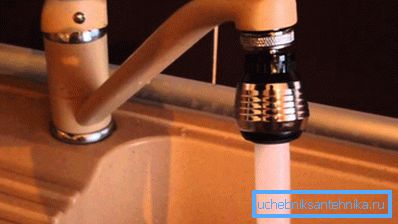
Ways to save water
When a person visits a bathroom and performs hygienic procedures, for example, he washes or brushes his teeth, the water often turns on all the time, that is, a considerable part of it is used up empty. It would be much more logical to turn on the tap only when bringing hands to it or at least limit the power of the stream running from the tap.
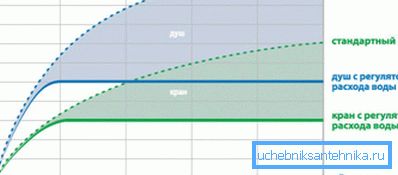
All types of devices for water saving can be divided into 2 large groups:
- special sensor cranes - such devices are installed on the sink instead of conventional faucets. A person in this case does not need to touch the sanitary equipment at all. It is enough to bring your hands to the tap, and the water will go by itself, and you can adjust its temperature in advance.
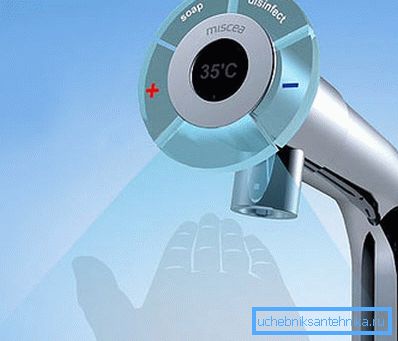
Note! Such cranes have a significant limitation on the scope. For example, it is illogical to install them in the kitchen, because in order to get water in the sink, you have to constantly hold your hand at the tap.
- nozzles that are mounted on a conventional mixer. Such devices due to internal geometry reduce water consumption.
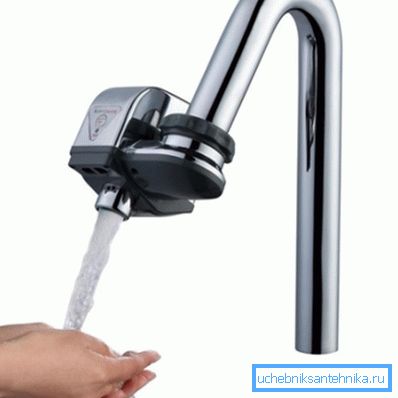
Such devices, in comparison with “smart” taps, are more popular due to the lower cost and ease of installation - it is enough to remove the usual mesh from the tap and screw the water-saving analogue using a gasket.
Saving water is the main goal of using such devices, but in addition to this several other beneficial effects are achieved:
- the pressure will be constant, even if constant pressure drops are observed in the water supply system. It is just that the passage through hole will constantly change in it, but at the outlet the flow will flow at a constant speed;
- Some models are equipped with a turning part at the outlet, they can change the direction of flow, which is very convenient;
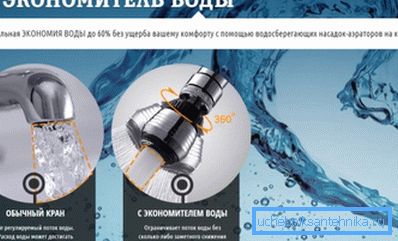
- the membrane can be considered as an additional filter;
- the usual crane is transformed and looks more impressive.
More on water saving nozzles
Manufacturers are trying their best, and even such a simple element as a nozzle on a crane is trying to make the most functional. There are several types of such devices on the market, all of which differ slightly in their proposed capabilities.
Types of nozzles on the crane
Such a device to save water from a tap as a nozzle can achieve a reduction in water consumption in 2 ways:
- by turning on / off the water. Externally, such devices look like a compact unit with a compartment for batteries, are installed on the faucet and, by their capabilities, are almost the complete equivalent of a sensor tap;
- nozzles, aerators, this group of devices regulates the flow due to the holes of different shapes and sizes.

Note! Although such devices and reduce water consumption, but people almost do not feel it, because the water jet is saturated with air and the pressure is maintained.
As for the nozzles of aerators, they, in turn, can be divided into such groups as:
- devices start / stop - in apartments they, as a rule, are not used. The design differs from the others in that in order to supply water you need to press a special valve on the aerator. Such nozzles can be considered the most economical, but it makes sense to install them in systems with a check valve;
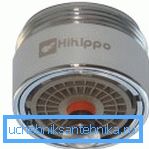
- fixed flow models. The documentation for the device indicates the flow of water that it provides, sometimes buyers buy several nozzles at once and change them if necessary, the price of one is about 300-400 rubles;
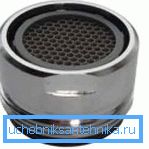
- As a subspecies of nozzles with a fixed flow rate, you can select individual inserts that you just need to place in a standard tap aerator. This is the budget option of all possible, the cost of such an insert is about 100 rubles;
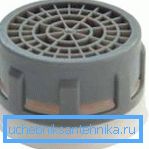
- Adjustable flow options are much more interesting. The design is only slightly more complicated compared to a conventional nozzle - in the center you can see the screw head that needs to be rotated to change the water flow. Due to this, the same device can operate with a throughput of 0.5 - 6.0 l / min.
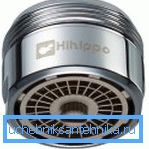
The device and principle of operation of the sensor nozzle on the crane
A special sensor detects the infrared radiation emitted by the human body and sends a signal to the water supply. Moreover, the dimensions of the area in which the sensor will "feel" the presence of a person can be adjusted in a fairly wide range (about 3 - 12 cm).
Note! Such devices can be installed including in the kitchen. Manufacturers equip nozzles with the function of continuous supply, that is, when switching the mode of water supply to the sink, it begins to flow, as if it does not exist at all.
It is very convenient that the additional power of the nozzle is carried out from ordinary finger-type batteries, and the device itself is supplied assembled, so that there will be no problems with installing it yourself.
Package Includes:
- the nozzle itself;
- adapters for different diameters of cranes;
- sealing gaskets;
- key to install.
From the features of using such nozzles it can be noted that they are not suitable for non-standard cranes. The fitting hole is round, so if the valve, for example, has a shape that is very different from a round one, you will have to abandon the use of such a nozzle.
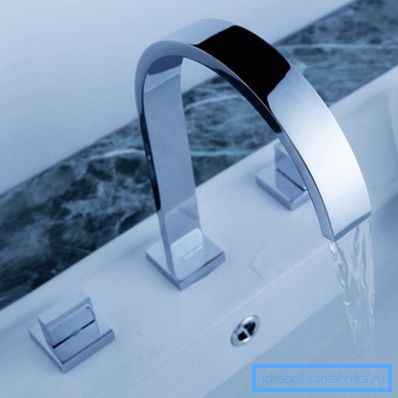
How does the aerator head
In short, the principle by which absolutely any nozzle-aerator works can be described as follows: water, passing through it, mixes with air in a ratio of about 1 to 3 (that is, water in the jet is only 30%, and the rest is air), then the jet at high speed flows from the crane. Due to the uniform distribution of water over the area of the tap hole, the decrease in the volume of incoming water is not felt.
The described process happens this way:
- water through the tap enters the nozzle through a rather narrow opening;
- at a short distance from this hole there is a membrane with holes evenly distributed over its entire area, between the membrane and the entrance to the nozzle, when the water is turned on, a zone with increased pressure is formed;
- at the exit of the nozzle on the crane - the water saver is equipped with a mesh, a small vacuum is created between it and the membrane. Due to this, the air is sucked into this area through the gap around the perimeter of the nozzle, the water is saturated with air;
- Then the water-air mixture passes through the mesh and breaks up into separate streams, which form a stream of water from the tap.
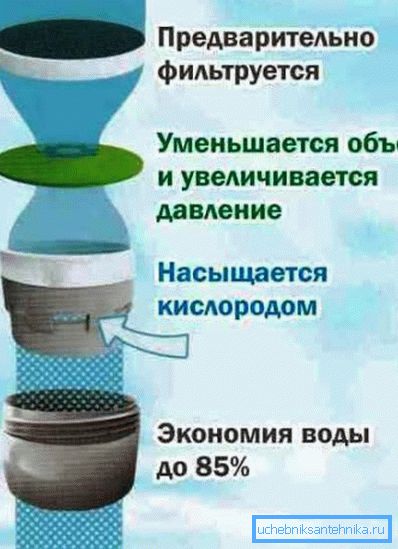
Quite often, such devices use this design to reduce water consumption:
- in the plastic washer in the center is a hole in the shape of a star;
- the size of the bore corresponds to a rubber sealing ring, which regulates the size of the bore depending on the head;
- if the pressure is weak, then the sealing ring remains virtually undeformed, i.e. the size of the bore remains unchanged. With an increase in pressure (and, accordingly, water consumption), the sealing ring deforms and almost completely blocks the passage opening, thereby reducing water consumption and flow rate.
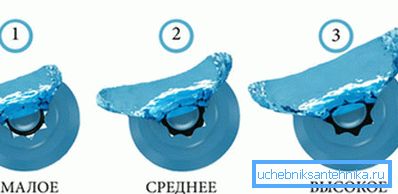
As for the flow control, this can be achieved in two ways:
- by turning the screw on the nozzle itself, due to this, the sealing ring is deformed and the passage is reduced;
- Another way to change the water flow is simply to change the ring to another (thickness and height differ). There are special sets of rings for sale, and each color and thickness of the ring corresponds to its own flow value.
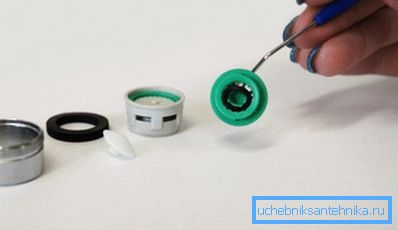
For example, for a flow rate of 14 l / min, you need to remove the rings from the aerator, to reduce this indicator to 8.0 l / min, you need to insert a simple 1 red ring, and to reduce it to 4.0 l / min, use 2 rings of increased thickness .
How to install the nozzle?
And the infrared nozzles on the faucet to save water and the usual analog-aerators are installed in a similar way - simply remove the mesh from the mixer and screw the water-saving device into it. The package includes all the necessary adapters (in the case of touch devices, the manufacturer sometimes adds a key to the kit).
Installing an IR device to save money is done in this order:
- first you need to unscrew the old mesh from the tap;
- complete with it should go fixing ring, it must be put on the crane;
- if necessary, a special adapter is screwed into the valve (also included);
- then the nozzle itself is screwed onto the mounting ring.
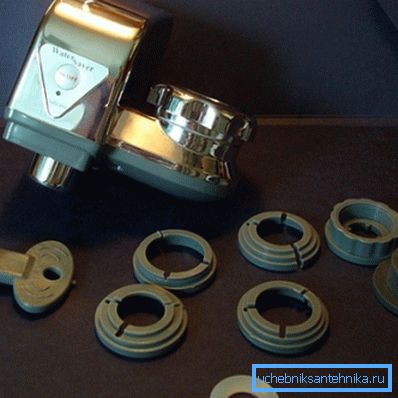
But for ordinary economists, aerators installation process looks easier. On the metal case of such a nozzle there is an external thread, it is simply screwed into the tap.
Preparation of the nozzle for work, operating rules
The device of the nozzle is quite simple, but, despite this, its life can be extended by observing a number of simple rules:
- It is forbidden to wash such devices with special chemicals. Household chemicals do not have the best effect on the state of plastic and rubber elements; rubber gaskets can lose elasticity and crack, which will reduce the capabilities of the device in terms of water saving;
- when reducing the pressure, you just need to check the outlet of the nozzle, most likely, the outlets are simply clogged, although water-saving devices are almost not clogged compared to conventional ones;

- Touch devices must not be immersed in water - this may damage the electronics (control unit).
In general, an infrared device is “capricious” compared to conventional ones, in particular, the sensor sometimes starts to work incorrectly, that is, it does not pay attention to the hands brought to it.
Instructions for eliminating small problems in the work looks like this:
- you need to gently wipe the sensor, and then hold down the "Reset" for at least 5 seconds in order for the device to work again. If nothing changes, then you can get and then again insert the batteries from the compartment;
- in order to properly turn off such a nozzle, you must first activate the manual mode, then turn off the water supply from the tap. Automation will turn off the device automatically;
- as for the process of switching on, the valve first opens to the desired pressure, and then the device itself turns on. After about 60 seconds, the device will begin to work in automatic mode.
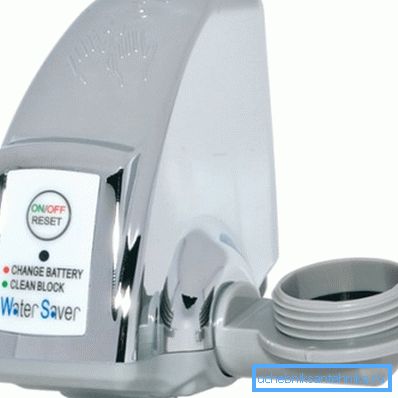
From the general rules that must be followed when dealing with such devices, we can note the following:
- do not include the maximum pressure - this increases the load on the device and reduces its service life;
- if the faucet is old, then it is better to replace it and install a saving device on the new faucet;
- "Smart" nozzles can formally be classified as electrical appliances, and they should be handled appropriately. In particular, it is recommended to remove it at the time of a long absence.
Summarizing
Saving water is a global trend, and besides abstract concern for the future of the planet, it will also bring tangible benefits to the family budget. Significantly reduce water consumption will help simple nozzles, aerators on the faucet, as an option, you can consider a more expensive counterpart - sensor devices.
The proposed material will allow to understand the principle of operation of common "economists" of water. A short video in this article reveals the principle of operation of an inexpensive but effective economy of water.